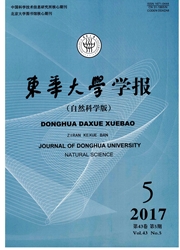

 中文摘要:
中文摘要:
由壳聚糖(CS)和单体N一异丙基丙烯酰胺(NIPAm)进行聚合反应,以N,N-亚甲基双丙烯酰胺为交联剂,以过硫酸铵为引发剂,采用无皂乳液聚合(SEP)法在不同温度(50,60和70℃)下合成了CS/PNIPAm基微凝胶.反应过程中定时取样,采用动态光散射法(DLS)检测胶体粒子尺寸、多分散指数PDI和粒子尺寸分布随反应时间的变化,推测反应机理.采用透射电镜(TEM)、扫描电镜(SEM)、傅里叶变换红外光谱(FTIR)、核磁共振氢谱(1HNMR)及DLS分别表征微凝胶的表面形貌、组成和化学结构及其温度和pH值响应性.测试结果表明:微凝胶粒径分布均一、具有核壳结构,组成中含有CS和PNIPAm及接枝共聚物CS-g-PNIPAm,产物具有温度和pH值响应性.
 英文摘要:
英文摘要:
Chitosan (CS)/poly (N-isopropylacrylamide) ( PNIPAm)-based microgels were prepared with soapless emulsion polymerization(SEP) method in different temperature (50, 60,70 ~C), with CS and N-isopropylacrylamide (NIPAm) as main reagents, N, N-methylene bisacrylamide as crosslinker, and ammonium persulfate as initiator. The mechanism of SEP was verified with dynamic light scattering (DLS) technique by characterizing the particle evolution (i. e., particle diameter, polydispersity index (PDI) and the distribution of particle diameter) during the reaction. Transmission electron microscopy (TEM), scanning electron microscope (SEM), Fourier transform infrared spectroscopy ( FTIR), ~ H nuclear magnetic resonance (1HNMR) and DLS were performed to characterize the microgles' morphology, chemical constitute and structure, as well as thermo- and pH-responsiveness, respectively. Results found that CS/PNIPAm microgel had core-shell morphology, with CS and PNIPAm as main constitutes and CS-g-PNIPAm copolymer in the composite. The theromo- and pH-responsiveness of CS/ PNIPAm-based microgels were also confirmed.
 同期刊论文项目
同期刊论文项目
 同项目期刊论文
同项目期刊论文
 Effects of expandable graphite and dimethyl methylphosphonate on mechanical, thermal, and flame-reta
Effects of expandable graphite and dimethyl methylphosphonate on mechanical, thermal, and flame-reta Solvent dependent photophysical properties andnear-infrared solid-state excited state intramolecular
Solvent dependent photophysical properties andnear-infrared solid-state excited state intramolecular Absorption kinetics andthermodynamics of cationic dyeing on easily dyeable copolyester modified by2-
Absorption kinetics andthermodynamics of cationic dyeing on easily dyeable copolyester modified by2- Template-directed synthesis of hierarchically mesporous superparamagnetic carbon-coated nickel nanop
Template-directed synthesis of hierarchically mesporous superparamagnetic carbon-coated nickel nanop Fluorescence Sensor Performance of a New Fluorescein Derivate: [2-Morpholine-4-(6-chlorine-1,3,5-s-t
Fluorescence Sensor Performance of a New Fluorescein Derivate: [2-Morpholine-4-(6-chlorine-1,3,5-s-t Potentiostatically synthesized flexible polypyrrole/multi-wall carbon nanotube/cotton fabric electro
Potentiostatically synthesized flexible polypyrrole/multi-wall carbon nanotube/cotton fabric electro Robust superhydrophobic, and photocatalytic cotton fabrics based on TiO2-SiO2-PDMS composite coating
Robust superhydrophobic, and photocatalytic cotton fabrics based on TiO2-SiO2-PDMS composite coating Electrochemical deposition and characterization ofcopper crystals on polyaniline/poly (ethylene tere
Electrochemical deposition and characterization ofcopper crystals on polyaniline/poly (ethylene tere Controlled Preparation and Formation Mechanism of Hydroxyapatite Nanoparticles under Different Hydro
Controlled Preparation and Formation Mechanism of Hydroxyapatite Nanoparticles under Different Hydro Controllable preparation and properties of active functional hybrid materials with different chromop
Controllable preparation and properties of active functional hybrid materials with different chromop Polyaniline-graphene composites with a three-dimensional array-based nanostructure for high-performa
Polyaniline-graphene composites with a three-dimensional array-based nanostructure for high-performa The investigation of the hydrogen bond saturation effect during the dipole-dipole induced azobenzene
The investigation of the hydrogen bond saturation effect during the dipole-dipole induced azobenzene A high performance carbon fiber precursor containning ultra-high molecular weight acrylonitrile copo
A high performance carbon fiber precursor containning ultra-high molecular weight acrylonitrile copo Fluorene-Based Click Polymers: Relationship Between Molecular Structure and Nonlinear Optical Proper
Fluorene-Based Click Polymers: Relationship Between Molecular Structure and Nonlinear Optical Proper POSS-based molecular hybrids with low dielectric constant: Effect of chemical structure and molecula
POSS-based molecular hybrids with low dielectric constant: Effect of chemical structure and molecula 期刊信息
期刊信息
